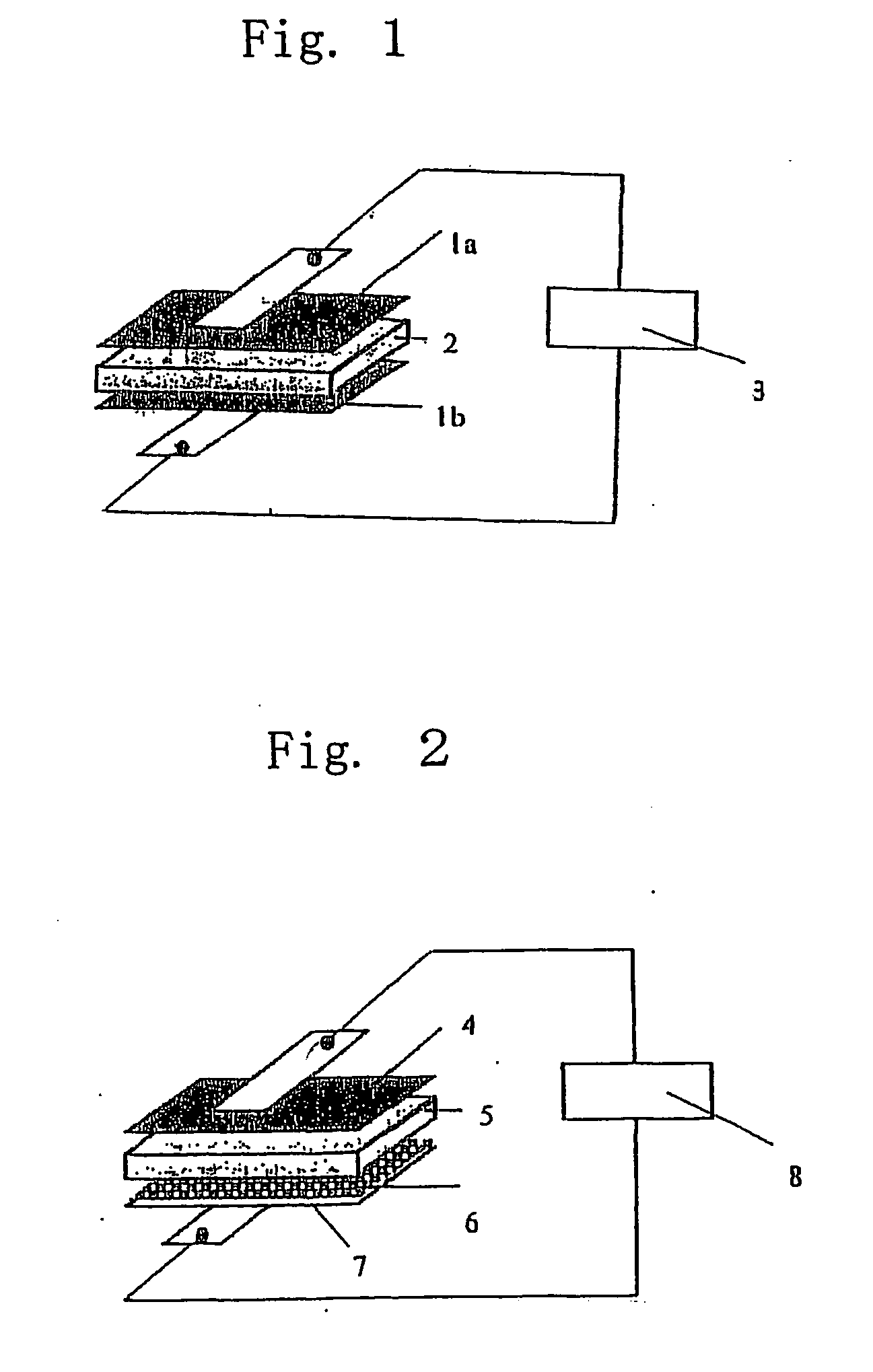Gel-type polymer electrolyte and use thereof
a polymer electrolyte and polymer technology, applied in the field of gel-type polymer electrolyte, can solve the problems of inability to absorb and hold large amounts of electrolyte, inability to use, and inability to meet the energy density and output density
- Summary
- Abstract
- Description
- Claims
- Application Information
AI Technical Summary
Benefits of technology
Problems solved by technology
Method used
Image
Examples
preparation example 1
[0121] 183 Gram of a polyethylene glycol monomethyl ether PEG-MME (number average molecular weight of 550, 0.33 mol of hydroxyl groups) and 1.5 g (0.0079 mol) of a hydrate of paratoluenesulfonic acid (molecular weight of 190) were introduced into a 500-ml four neck flask.
[0122] The mixture was heated up to 140° C. with stirring, and, while blowing nitrogen (0.1 m3 / hr) through a capillary tube, 100 g of an ethylene-acrylic acid copolymer (0.28 mol of carboxylic acid group, molar ratio (BHYD / ACAR) of hydroxyl group / carboxylic acid group=1.18) was gradually added while confirming the dissolving state (over about 30 minutes). After the addition has been finished, the mixture was reacted at the same temperature for 24 hours.
[0123] After the reaction, the reaction product was taken out into another container and, after cooled, was cut into a size of about 1 cm3. 500 ml of ethanol was added thereto at room temperature. After immersed for 70 hours, the ethanol solution was removed by deca...
preparation example 2
[0128] 154 Gram of the polyethylene glycol monomethyl ether PEG-MME (number average molecular weight of 550, 0.28 mol of hydroxyl group) and 1.28 g (0.0067 mol) of a hydrate of paratoluenesulfonic acid were introduced into a 500-ml four neck flask. The mixture was heated up to 140° C. with stirring, and 100 g of an ethylene-acrylic acid copolymer (0.28 mol of carboxylic acid, BHYD / ACAR=1.00) was gradually added.
[0129] Then, the operation same as that of preparation Example 1 was repeated but changing the reaction time from 24 hours into 16 hours.
[0130] Observation of FTIR spectrum of the esterified product indicated, as a shoulder, an absorption peak (νCO=1700 cm−1) due to the carbonyl group of the unreacted free carboxylic acid.
[0131] Due to the titration with KOH, there remained 5 mol % of carboxylic acid of ethylene-acrylic acid copolymer (0.014 mol in 0.28 mol of carboxylic acid).
[0132] The titration with KOH was conducted by heating and dissolving 5 g of the sample in 200 g...
preparation example 3
[0135] 123 Gram of the polyethylene glycol monomethyl ether PEG-MME (number average molecular weight of 550, 0.224 mols of hydroxyl group) and 1.02 g. (0.0054 mol) of a hydrate of paratoluenesulfonic acid were introduced into a 500-ml four neck flask. The mixture was heated up to 140° C. with stirring, and 100 g of an ethylene-acrylic acid copolymer (0.28 mols of carboxylic acid, BHYD / ACAR=0.8) was gradually added. The operation same as that of preparation Example 1 was repeated but changing the reaction time from 24 hours into 16 hours.
[0136] Observation of FTIR spectrum of the esterified product indicated, as a shoulder, an absorption peak (νCO=1700 cm−1) due to the carbonyl group of the unreacted free carboxylic acid.
[0137] Due to the titration with KOH, there remained 24 mol % of carboxylic acid of ethylene-acrylic acid copolymer (0.067 mols in 0.28 mols of carboxylic acid).
[0138] The obtained product was regarded to be a polymer electrolyte material C.
[0139] Composition of ...
PUM
| Property | Measurement | Unit |
|---|---|---|
| melt flow rate | aaaaa | aaaaa |
| ionic conductivity | aaaaa | aaaaa |
| mol % | aaaaa | aaaaa |
Abstract
Description
Claims
Application Information
 Login to View More
Login to View More - R&D
- Intellectual Property
- Life Sciences
- Materials
- Tech Scout
- Unparalleled Data Quality
- Higher Quality Content
- 60% Fewer Hallucinations
Browse by: Latest US Patents, China's latest patents, Technical Efficacy Thesaurus, Application Domain, Technology Topic, Popular Technical Reports.
© 2025 PatSnap. All rights reserved.Legal|Privacy policy|Modern Slavery Act Transparency Statement|Sitemap|About US| Contact US: help@patsnap.com



